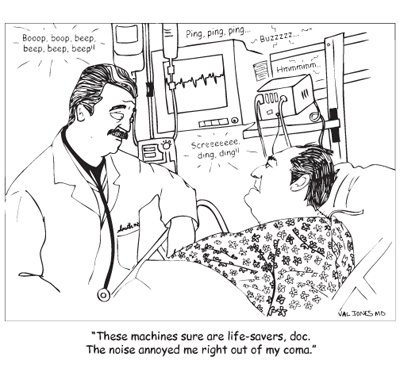
October 17th, 2011 by Happy Hospitalist in Opinion, Research
Tags: Documentation, Efficiency, Government Regulations, Hospitalist, Insurance Companies, Paperwork, Patient encounters, Patients, Potential, Quality of Care, Survey
No Comments »

How many patients should a hospitalist average on any given day? What do you think? The Hospitalist asked that question to hospitalists and 421 of them responded. They were given responses in quintiles of 10 or fewer, 11-15, 16-20, 21-25, and more than 25 total patient encounters per day.
Go check out their results. I’m not surprised. But, as they say, there is no right answer. The right number is the number that brings WIN-WIN-WIN-WIN to the patient-doctor-hospital-insurance quadrangle. WIN-WIN-WIN-WIN is possible. It just takes a great understanding of removing the barriers to efficiency. Efficiency and quality of care can move in the same direction. They don’t have to be opposing forces. You can be better and faster if given the tools, whether those tools are driven by IT support, systems process changes, communication enhancement, physical and structural hospital layout changes or documentation support tools. There are many others. Read more »
*This blog post was originally published at The Happy Hospitalist*
October 17th, 2011 by DrWes in Opinion
Tags: Asking questions, Communication, Connection, Doctor Patient Relationship, Learning, Medical Education, Medicine, Personal, Relationship
No Comments »

There they were, little maroon flags outside three patient exam room doors. You could almost hear the game show host ask the question:
Will it be Door #1, Door #2, or Door #3?”
So I asked the medical assistant, “Who’s next?” and she pointed me to Door #2.
It was a new patient with a familiar problem, one I’ve seen probably a thousand times before. Another day, another case. Bada bing, bada boom. Nothing to it. You would think that all cases, and all people are the same in some ways. Certainly, those managing our health care system of the future would like us to believe it’s so simple: just another case of heart failure (what can go wrong?) or supraventricular tachycardia (love that one, there’s NOTHING hard about that!) or maybe a few PVC’s (Check). Read more »
*This blog post was originally published at Dr. Wes*
October 16th, 2011 by ChristopherChangMD in Opinion
Tags: Decision, Distrust, Life-Threatening, Medical, Medicine, Patient, Personality, Physician, Procedure, Surgeon, Surgery, Surgery Clinic, Treatment, Type
No Comments »

 Over the years, I have found that patients can be loosely grouped into 4 different types. Nothing particularly wrong with any type, but it does help me to approach patients appropriately if I can get a sense of what type they are.
Over the years, I have found that patients can be loosely grouped into 4 different types. Nothing particularly wrong with any type, but it does help me to approach patients appropriately if I can get a sense of what type they are.
The four types are:
Type A: If a surgery can “fix” or “cure” me such that I won’t have to take medications every day of my life, than let’s do it.
Type B: I will never consider surgery unless it is a life-threatening situation. If a medicine can help, why do it???
Type C: I will consider surgery only as a last resort when all else fails.
Type D: Read more »
*This blog post was originally published at Fauquier ENT Blog*
October 15th, 2011 by Bryan Vartabedian, M.D. in Opinion
Tags: 21st Century, Attention, Brian McGowan, Complexity, Evolution, Information, Information Choreography, Intelligence, Limitless Inputs, Progress, Solutions, Technology, Twitter
1 Comment »

I woke up this morning, tapped my digital signal, and found this from Brian McGowan on Twitter: “What happens when complexity races ahead of the mind’s ability to adapt? When progress outpaces evolution? We need new solutions.”
Like a slow hunch, a version of this idea has been rattling around in my head for some weeks. Specifically: Is there a new kind of human intelligence evolving? Will our ability to work with knowledge in the face of limitless information select for a new kind of thinker in the 21st century? I suspect it will. Thinking and the creation of new ideas will require Read more »
*This blog post was originally published at 33 Charts*
October 15th, 2011 by AndrewSchorr in Opinion, True Stories
Tags: Death, Good Health, Houston, Life Expectancy, Mary Sharkey, Mortality, Neuroendocrine Tumor, Pancreatic Cancer, Progress, Pursuit of Care, Search for a cure, Seattle, Steve Jobs, Sunil Hingorani, Treatment
No Comments »

It’s too young to die at age 56. It’s too young to die when you have four children and a wife. It’s too young to die when you have led one of the most successful technology companies ever. It’s too young to die when you are very rich, have so much more to do and to give back. But pancreatic cancer doesn’t care. This time, again, one of our most deadly cancers won.
Medicines, nutrition, surgery, liver transplant, apparently Steve Jobs, celebrated CEO of Apple, tried them all. But, as I wrote in a recent blog, continuing was just too much. To be sure, Jobs did not have the most common type of cancer in his pancreas. His was a neuroendocrine tumor and life expectancy can be longer. But, as has been noted widely in the media, Steve Jobs came to know that his mortality clock was ticking. His eight year-survival was probably what he knew he was facing all along. Read more »
*This blog post was originally published at Andrew's Blog*






 Over the years, I have found that patients can be loosely grouped into 4 different types. Nothing particularly wrong with any type, but it does help me to approach patients appropriately if I can get a sense of what type they are.
Over the years, I have found that patients can be loosely grouped into 4 different types. Nothing particularly wrong with any type, but it does help me to approach patients appropriately if I can get a sense of what type they are.









